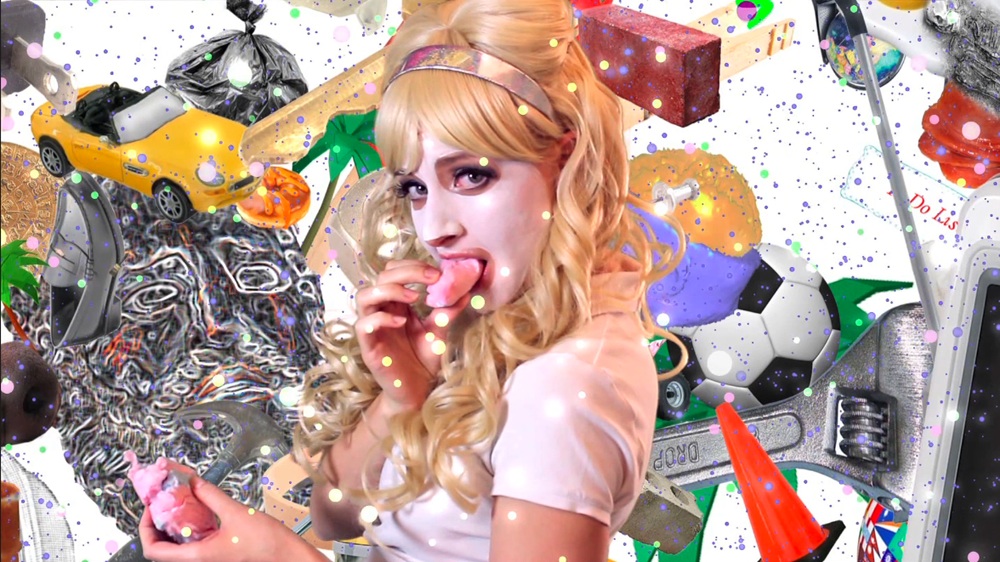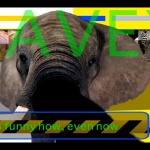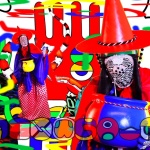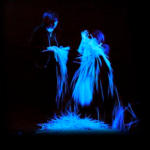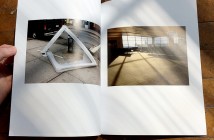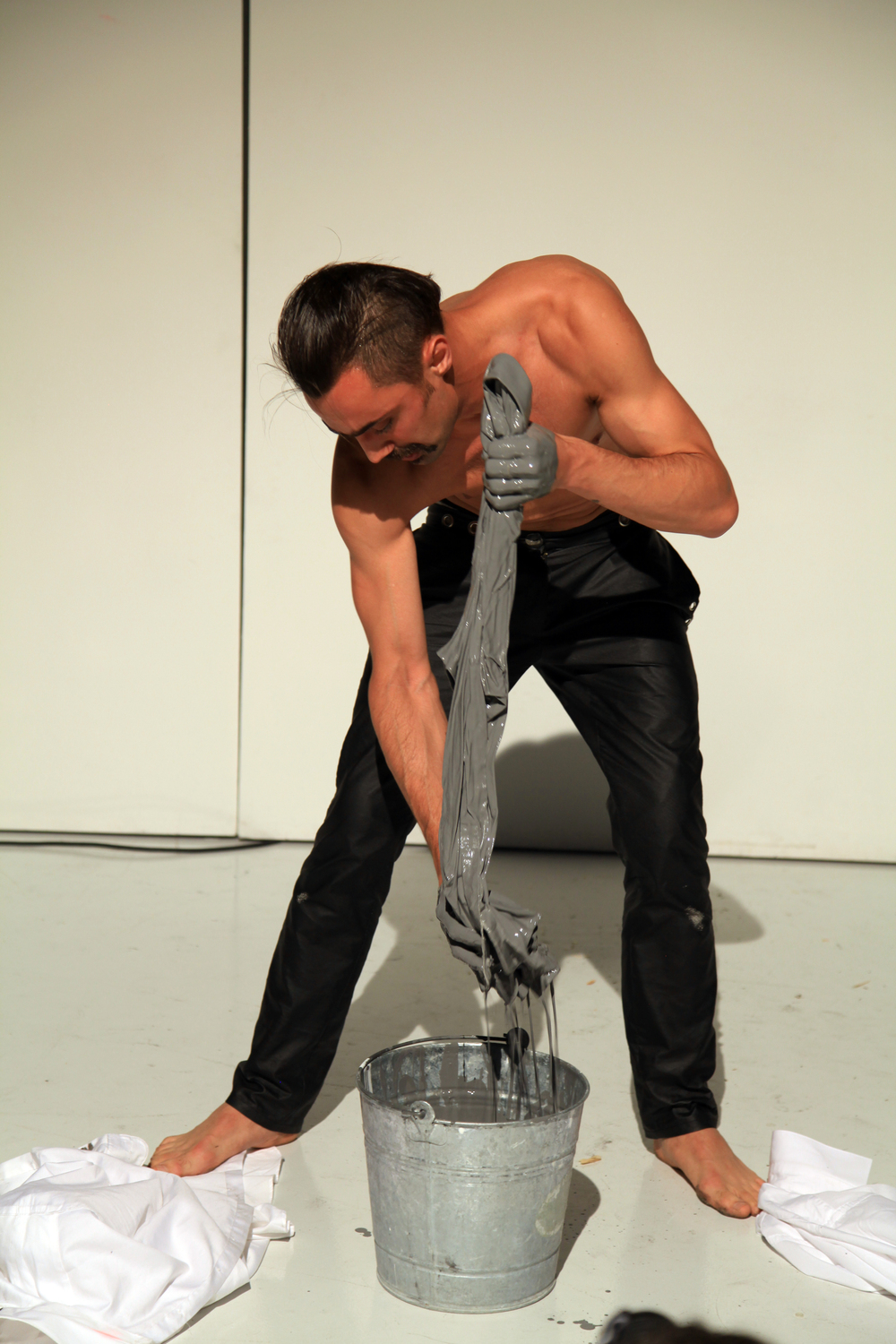•••
Sandrine Schaefer Much of your work is made for the Internet. What are some of your initial thoughts on this choice?
Bradley Benedetti I use the Internet because it’s free and easy. It allows me to do art on my own time. I like the idea that someone would be bored, find my work, and spend hours scrolling through it, similar to scrolling through Tumblr or Twitter. This is especially relevant with my project, Demiurge in the Cupboard, Circusology of Native Leadership I cut up the movie and put it on the Internet in clips. Twitter, Facebook updates, Tumblr, these are experienced as moments and fragments. People really like moments. Experiencing something in fragments gives the brain the ability to fill in the gaps.
This is something I enjoy about looking at live performance. If I’m watching a person fill up a bucket of water, for example, my imagination places the action somewhere else. When you experience a mundane thing out of context (especially within the white walls of a gallery) you can project that action into an imaginary space. The Internet is already imaginary. You can be whomever you want on the Internet. You can control personal settings until the performance becomes a reality.
When you literally look at a computer, it looks like a book, yet there is a world in there. It’s a flat plane, but it is a window. It's a magic window. It’s animating sound and colors when you look through it, you are learning, absorbing, communicating, loving, and living. Making work for the computer is important. The computer is our library, our telephone, our newspaper, and our bank. It is our real world.
SS An advantage I see to making work online is that your audience can respond through their intuition in a way that they can’t when experiencing a live piece. There are barriers presented through an etiquette of witnessing. Do you feel that there is etiquette of witnessing artwork on the Internet?
BB Yes and no. There is an etiquette that some people hold others to, but then there's trolling. When I put something online, I know that there is a high possibility of it being reblogged, people might take screen shots and use it as their own, or they might parody it. I actually like that because it means that I am producing something that someone else can use. I am probably subconsciously referencing a meme or something else someone else blogged too. It’s like throwing a cup in the trash. Someone else can go into the trash and take whatever they want and do whatever they want with it because it’s free. The Internet is totally free! I purposefully make art for the Internet because I get bored with standing in front of a projection in a museum or gallery. I love the idea of an academic museum setting. Having work presented in that context is nice because it reaches audiences that don’t go online to seek it out. You also get to see the work in a different form, but traditional art spaces kill the art the minute that it is put there. An online piece lives forever. Even if it turns into digital ruins, people can still access those digital ruins. They can access it for free and at any time they want.
SS We look at everything on the Internet. We look at images of people, animals, places, words, etc. This makes it a neutral but somewhat chaotic space. Being able to revisit work for free at any time in any place is important in creating an opportunity for people to distill the conceptual intention of the piece. I am thinking specifically about the videos you’ve made around the personae, Vlad Kromatika. The images of Vlad are often composed in a way that is familiar to us, similar to any normal profile picture, but then you add layers of visual and audio complexity.
BB With my work, CHARISMATIC MEGAFAUNA, the idea was to make an interface that looked as though animals were interacting with it. That’s a theme I’m always working with...a species-wide interface and communication. That was why I created the character, Vlad Kromatika, when I first started using social media-MySpace. I could communicate "me" more accurately by using an interface than I could in real life. I want to be multicolored and always glitching and free to jump between different personalities without people questioning it. People don’t question art online. Art always gets the license to be zany and weird for art’s sake, but online it’s different. The Internet is a no man’s land. The Internet is a grey area. If the work is seen online, it’s unclear if it’s art or not art. I love interfaces for that reason. It walks the line between being and making art. This opens up the possibility of breaking the interface.
The Internet also creates opportunities for expression for people who may not be artists. Artists today are taking this sincerity and repurposing it by placing it in the established settings of galleries and museums to pass it off as art. In these contexts, however, the feeling of the Internet and the sincerity is lost. The feeling that someone is making something "just because" is gone. If people encounter my videos on YouTube, they most likely won’t think it’s art and I hope they don’t. I hope that they see that it’s me being me, because that is what it really is.
SS Do you feel uncomfortable being called an artist?
BB I never introduce myself as an artist. I make work and I have fun playing around. I play with the tools I have access to today.
SS I am interested in how you are using personae in your work. I’m thinking about Demiurge in the Cupboard Do you feel that all of the characters are extensions of yourself?
BB Yes, but I had other people play them. I played multiple characters too, but I included other people because I like the idea of creating an interface community. Demiurge was written to be very performative. I needed many characters and I needed them to perform in very specific ways, but they had to be taken out of their contexts because the piece was about getting rid of culture on Earth. The whole point of the movie is about restarting humanity. They attempt to reset humanity. They fail, so they have to restart it again. No one will understand this from watching Demiurge… in clips. I like that the narrative gets lost in the delivery, because that’s the part of the concept.
It was also important for all the characters to address the viewer. I love watching videos on YouTube where people are talking to the camera, whether it is makeup tutorials, someone talking about a bad day they had at school, or moms talking about what they just bought and wish they could return. The feeling of watching these videos is what Demiurge’s narrative was born out of. In the movie, I am also video tweeting, but about things like deleting culture and creating an equal area for all species.
What is important about the Internet is being able to share and its mystique. Some people really think my name is Vlad and all of the other aliases and accounts that I have used online. That’s what is so fun about making performance online. You can be a lot of different people at the same time.
SS What role does gender play in your work?
BB I have always stayed away from labeling my work or myself as "queer." I don’t post my sexuality online and my work isn’t sexual. The reason I haven’t done that is because I don’t operate in that zone. What I like about creating personas online, (this also carries over into my everyday being) is I can be any gender. I can alter my voice. I can be whatever I want. I am not male, female, or animal. I am a being. Some people have read my work as drag, or gay, or trans and it is all of those things. I like the idea of moving beyond all of those labels, because I think people can get caught up on them. The whole reason I am presenting this idea of deleting culture is not to forget about the histories of different cultures. It’s about moving through cultural obstacles to create a new existence for all life forms. For me, art has always been a fantasy. Maybe it’s my avoidance of reality, but I have always used art as a fantastical portrayal of what I want the world to be like. I like to jumble everything up into a balance that has room for all things. It kind of comes out in the form of an angsty teenager.
SS I appreciate the existential aesthetic of your video work. There are so many images, symbols, and sounds existing in the same plane. It really does level the playing field and creates a sense of equality.
What would deleting culture look like?
BB Confusion. Confusion, then a rebirth. It can be difficult and you have to be really sensitive when you are making work and you address concepts like "getting rid of the past." When I say this in Demiurge I have to be sensitive to everyone who has been hurt by the past. You obviously can’t ignore that. I have no intention of doing that or literally deleting the past. This is about making a new future by stepping into tomorrow, today. I don’t want people to think that I am trying to get rid of the past by sweeping it under the carpet. Demiurge is about the fact that you can’t delete the past. When they reset, it just isn’t enough. They have to start the cycle over again.
SS How has the Internet changed since you started making work for it?
BB It’s become faster and easier to share. You can tweet, tumble, instagram, Facebook, you can still MySpace, Google, Bing, etc. And now I have an iPhone. I was anti-iPhone until I got an iPhone. Now I can make a video on my phone and upload it to Twitter and it’s everywhere. Within hours you can spread art to millions in contrast to a piece shown at a gallery where potentially no one will see it.
SS I see parallels between sharing technologies and the way in which the performance art communities with function. When I share memories of a live piece with other people who have witnessed the same piece, our recollections move through our dialogue in a way that is similar to how information moves through Twitter, Facebook, etc. It is a collection of moments and fragments. Together we are able to create a collective memory/archive of the piece.
Smartphones have really changed things too. There used to be only one or two photographers (if you were lucky) at performance events/ happenings. Now, everyone has a camera. The work spreads through these objects and each person’s network. It’s a form of collective archiving. This has inspired a lot of change in ways that performance art is being documented today. I think performance made for the screen has also had a big influence.
BB A lot of people are aware of performance art now. They think they know what performance art is. A lot of my videos are overly decorative because for me, it is about making the reality a fantasy. I treat my videos like a children’s show. Adults need to be treated like children, even more than children need to be treated like children. If I make something look like a piece of gooey disgusting candy, people will look at it. It also makes it funny. I think a lot of live performance wants to be taken seriously. When I’ve watched a performance and someone in the audience starts laughing, I have the instinct, "They shouldn’t be laughing." It feels like they’re breaking the rules.
SS An example of the etiquette of witnessing...
BB Yes. When looking at a performance online, you can laugh, you can call something stupid, you can anonymously comment. People will comment. Whether you want it or not, you are getting feedback if you put your work online. Those comments go with the work.
Take Bas Jan Ader’s I’m Too Sad to Tell You. People have made thousands of tributes to that piece and put them all over the Internet. People have also blingied the image of him crying. He was making an ironic statement with that piece that becomes even more ironic by the way it’s been treated online. The art world has an overactive preciousness. You cannot be precious on the Internet. I can edit my work all I want, but I give it to the wolves when I put it online. If you take yourself too seriously on the Internet you’ll have to defend yourself and you’ll never be able to. You have to be willing to have fun.
SS I think I’m Too Sad To Tell You is timeless and relatable which is why so many people create tributes to it. It is an interesting notion that the Internet can be used as a tool to change the aesthetic of a piece to make it more relevant to today. Someone might see an image of Bas Jan Ader crying glittery pink tears, surrounded by cupids and something about that image sparks a sincere authentic reaction that would get lost if the same person only saw the black and white image.
Do people contact you about the work you put online? Do you feel like you have a sense of how far your reach is?
BB People contact me, but on some level, we’ll never know. But that’s the nature of the 'net. For example, if you’re on Tumblr, you often don’t know who’s making the Tumblr, or you may see an image you love, but you don’t know where the image came from. At the beginning I was really paranoid about that because I didn’t like the idea of my images being online and people using them and not crediting me, but then I had to just give up, because that’s what the Internet is. It’s a big trash bag. It’s a thrift store.
Would you ever make a performance that is Internet only?
SS I would. I haven’t, but I would. With my work there are the pieces that I make in the present moment that have always felt the most authentic to how I want to be working. With that said, documentation and archiving are important to me. Sharing documentation of my own work online has become a crucial part of my practice and more intentional. For example, when I am traveling to make work, I am usually alone or with one other person. There is a whole other life that the work takes on when I am able to share its documentation online.
BB I think the big difference between how you and I interact with the world is that you feel very comfortable in your physical body and I don’t. You use physical reality as an interface. I am hiding in the Internet. On the Internet, I can be me. I think this is why there are so many people on the Internet like me, is because we can all be "we" online. We can create our own avatar or brand of being that we can feel the most comfortable with. My personas are different expressions of me being comfortable. It’s like when you are a kid and you draw a picture of yourself with your family and your house. You can draw it however you want. That’s what I do with the Internet. I make it into the reality I want.
SS I would agree with that. I am also "hiding" in my work, but within physical space. I have learned how to use my body to fuse with different situations, objects, and cultures. It has required me to neutralize my appearance to a certain degree. What’s enticing to me about the Internet as a place for art is that online, absurdity is never absurd. Things that are taboo in any place are fair game on the Internet.
BB With your Adventures in Being (small) project, you are breaking down the expectations of how to use objects. People have an expectation of what to do with a phone booth or a bike rack and so on. I like the Internet because everyone can be on it and everyone can see everything, but there are so many ideas outside of the Internet. For instance, breaking the expectations of objects in physical space is interesting because you are the breaking rules that are based on these physical standards that people hold themselves to in the real world. If someone sees you crawling into a tube, they most likely will ask you what you are doing, but if you put a video of yourself crawling into a tube online, no one will care. Everything is acceptable online.
SS On the topic of breaking the expectations of objects… Can you talk about MAGICKWINDOWS No.1, where you placed a light and sound reactive piece of furniture in a space?
BB Yes, MAGICKWINDOWS was where Demiurge was born. It was also where Vlad was born. MAGICKWINDOWS is the work that is presented through The Center for Cognitive Chaos & Astral Physics Research. It’s about the idea of breaking the expectation of reality through the personification of "stuff" (animals, objects, everything). It was the idea that a window is a magical doorway into something else. Whether it’s a computer, an actual window in your house, a door, a gallery space, or a science lab. At the time that I made that work I was living around MIT and I would sneak into their labs. I wanted to be part of that community because I wanted to be part of something unreal. This led me to start working with the idea of the object performing, not me. The experiments that I have done and continue to do through MAGICKWINDOWS are about altering familiar spaces and objects through the viewer’s activation. If they choose not to activate it, they never see it.
This all stems from the spider web. The spider web is invisible sometimes and it’s not until you walk through it that you realize it’s there. It is an unseen window into life.
 BOMBASTIK PHANTASTIK
BOMBASTIK PHANTASTIK2.19.10 at 2.22pm untill 2.22.10 at 2.22am
Durational actionary displacement with holographic projection
In collaboration with Sandrine Schaefer
MEME Gallery
SS The idea of invisible space is something that I also am working with. This shared interest was apparent in our collaborative piece, Bombastik Phantastik.
For three days, we were physically present in a space during daylight hours. We engaged in super slow actions. At sunset, the space was filled with holograms of our bodies engaging in similar actions until the sun rose again the next day. Do you have any thoughts about the piece in hindsight?
BB One of the things I personally wanted out of that piece was that I didn’t want people to perceive the actions we were doing. I like the idea of something moving at a rate that is unperceivable and that things are happening at nighttime. Nocturnal beasts are right in front of your face, but you can’t see them because they are sleeping during the day or moving so slow that you would never pick up on their movements. Here we are, seemingly sleeping or dead in the space and at nighttime all that energy that has been stored manifests in a way that might be visible but is intangible. We were working with the idea of astral projection and dreams questioning reality. Dreams are certainly real. Every night, we all engage in a place on the astral plane with a physics of its own. That’s the reasoning behind The Center for Cognitive Chaos & Astral Physics Research. People question the validity of astral physics. I want to bridge the point of dreaming and reality through the work of MAGICKWINDOWS and through The Center. How can I merge dream and reality?
SS On the topic of astral projection can you talk about MAGICKWINDOWS No.2 in which the audience was invited one by one to sit in a chair to have sound reactive light pointed at their face in a temperature manipulated space?
BB With that piece, I wanted people to feel as though they were moving through a visual space without seeing anything at all, only feeling and hearing. It was based off of echolocation. Bats in their mind are creating a visual space by making sound. I think a lot of people don’t consider the idea of space and the senses. I feel that there is an exception with people making technology. This is why I go back and forth with being a Luddite. I love technology and I hate it. On one hand, technology takes me away from the physical world, but it also introduces me to a different world.
SS Can you talk about SAFARINON?
BB It is so easy to get lost in the daily culture of the human-made (music, art, computer culture, etc.) We don’t always acknowledge that there are other beings all over the world that are not living like this. We are lucky to live like this. I have the luxury of not worrying about being bombed or caged and sent off to a meatpacking factory. I believe our culture devalues the intellect of other non human beings on the earth. This is my intention behind SAFARINON. It obviously anthropomorphizes animals in some way, but it also is poking fun at organizations and brands that are always trying to "save," making themselves into some kind of Saviors. When you look at what they are doing they are often doing more harm than anything else. These organizations look at these creatures as scientists not as neighbors. They don’t acknowledge that they are animals looking at other animals. My SAFARINON Twitter is my version of these organizations. I am addressing humans in a way that is equal to other creatures on the planet.
SS That’s something that I appreciate about your work. The language you use in your videos is like computer code in some way. I have trouble understanding it. This makes me acknowledge the person on the screen as an animal. With your physical work where the audience is activating the object or space, they become very animal because you have set up a situation that they need to navigate instinctually. I think having experiences like this is really important. This is something that I am aiming for with my work too. I want to play on people’s psychology and behavior so that they can feel something instinctually. We are all too in our heads and we all have moments of falling into a place where we forget that we are animals. . . .
BB If you were to put a cat in a space, it isn’t going to walk around a sculpture or look at a painting, it’s going to smell it or lie down and ignore it. That is the whole point in what my interest is in having work in spaces. I want to make something that shows the instinct of a person.
SS I’m interested for you to elaborate on how you’re thinking about the concept of time and using it in your work.
BB I’m interested in editing time. I like controlling time through the Internet. The other reason why Demiurge is in so many different pieces is because it is a non-linear narrative. You never know the beginning or ending. There’s no middle or almost over, it’s constantly going. When you are watching videos on YouTube, one comes up after another. You move through a tunnel where you may have started by looking at someone’s portfolio, and you end up looking at a video of someone getting a puppy tattooed on their hand. You ask, "How did I get here?" I’m interested in the circular natural state of being that the Internet brings out in people. The Internet is completely endless and there is no time in the Internet.
I think this is also why I am always trying to engage other species. They are living in this world too and they are always living in the present.
SS That circular way of time is ancient and is present in the mythologies of different cultures. Are you intentionally referencing this in your work?
BB Yes, The full title of Demiurge is Demiurge in The Cupboard, Circusology of Native Leadership. This is about the circus, three rings, the three states of being, circular time, and this idea of native leadership, who originally began to lead and who has rite to space, etc. I was reading about the Navajo understanding of time, which is circular. The movie was a play off of Indian in the cupboard. It’s this idea of bringing life to something that isn’t alive.
SS You also read tarot. I see tarot cards as ancient interfaces in their own right. How does this practice overlap with your art making?
BB I started reading because the Tarot is a decision-making tool that is an ancient interface. It is asking the randomness of the universe to make a decision for you. As spiritual or metaphysical as you want it to be or as hokey as you want it to be, it’s still giving you an answer out of chance. Sometimes that randomness, more often than not, isn’t so random. You take a group of pictures and place them in a narrative and it is a way to have someone else look at that narrative so that you can examine your past, present, and future. After reading thousands of people, I am very aware of the patterns of life. And even though I see what’s going to happen, I am always surprised, because we are conditioned to think the universe is not supposed to work that way.
SS It’s like how you cut up Demiurge.
BB Yes. It’s also like putting your iPod on shuffle or reading Twitter, you realize that even when you look through the lens of randomness, it still makes sense and there are infinite narratives. The universe is made up of infinite non-narrative narrative.
- Bradley Benedetti from Demiurge in The Cupboard Circusology of Native Leadership 2009-2011
- Bradley Benedetti from CHARISMATIC MEGAFAUNA , 2012
- Bradley Benedetti from Demiurge in The Cupboard Circusology of Native Leadership 2009-2011
- BOMBASTIK PHANTASTIK 2.19.10 at 2.22pm untill 2.22.10 at 2.22am Durational actionary displacement with holographic projection In collaboration with Sandrine Schaefer MEME Gallery

